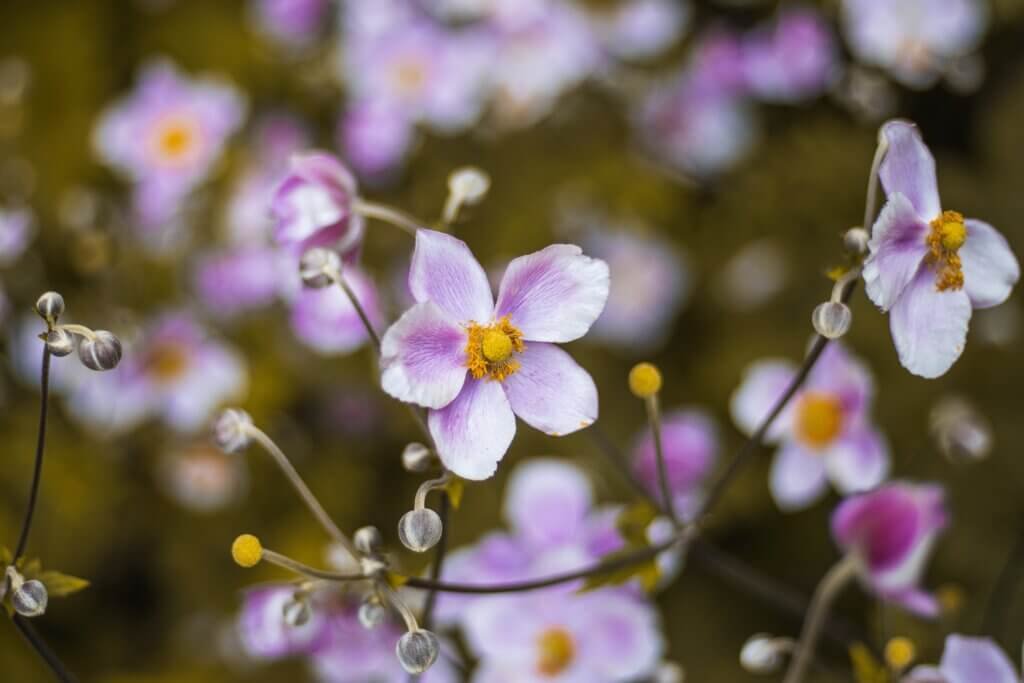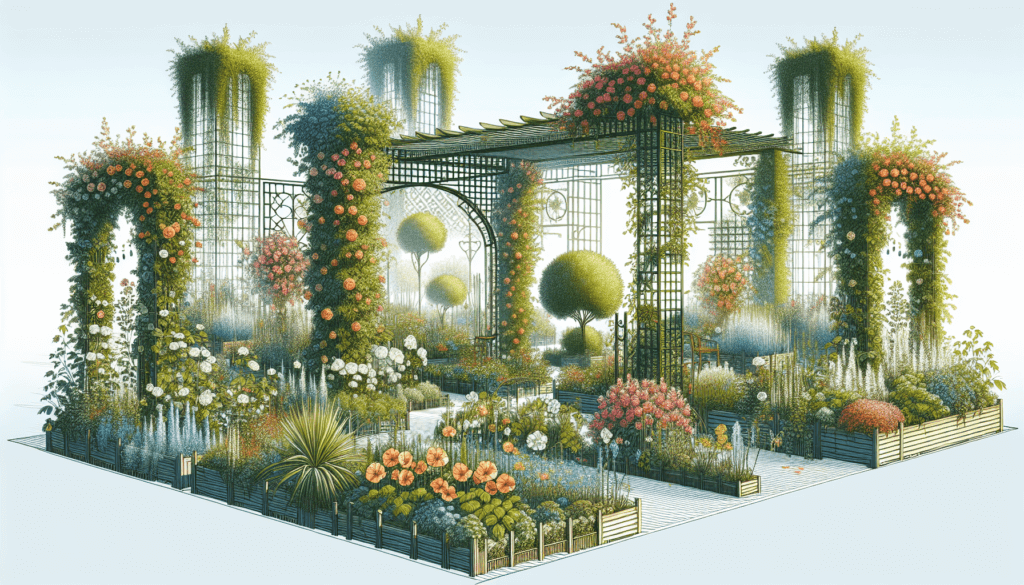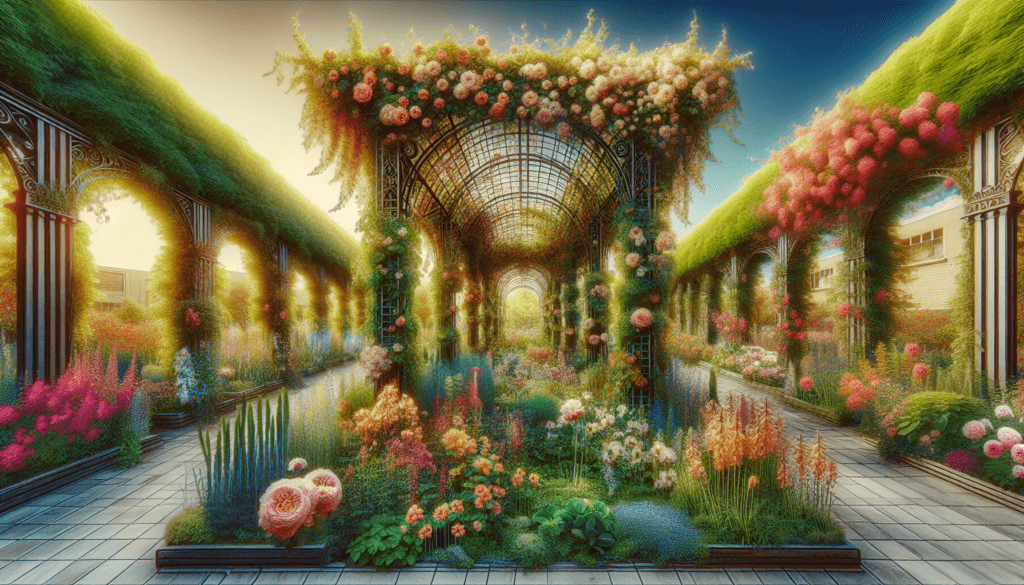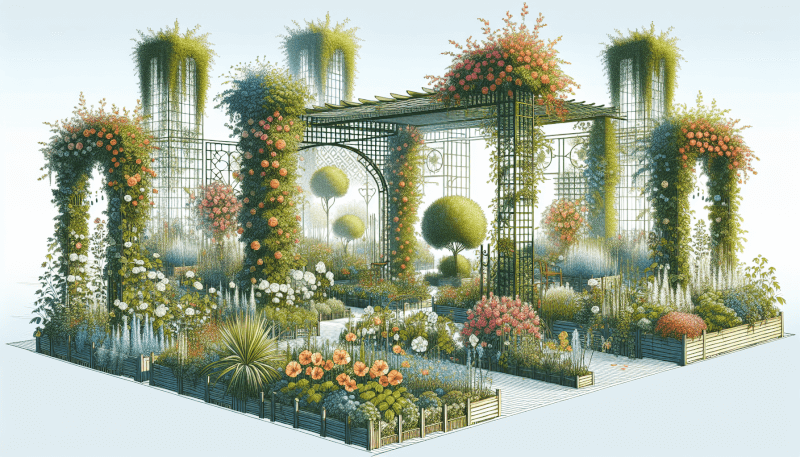If you’re an urban garden enthusiast looking to make the most of limited space, trellises and arbors are your new best friends. These versatile structures not only add beauty and height to your garden, but they also provide innovative ways to maximize the square footage available. By training climbing plants to grow vertically or along the sides of trellises and arbors, you can create a stunning vertical garden that not only saves valuable ground space but also adds a touch of elegance to your urban oasis. So, whether you have a small balcony, rooftop, or backyard, it’s time to unlock the potential of your urban garden with trellises and arbors.
Benefits of Using Trellises and Arbors in Urban Gardens
Increased Growing Space
One of the main benefits of using trellises and arbors in urban gardens is the opportunity to maximize growing space. In densely populated areas, such as cities, the availability of land for gardening is often limited. By utilizing vertical structures like trellises and arbors, you can take advantage of the vertical space in your garden. This allows you to grow more plants and crops without taking up valuable ground space. With trellises and arbors, you can transform a small urban garden into a lush and productive oasis.
Vertical Gardening
Vertical gardening is a popular technique among urban gardeners, and trellises and arbors play a crucial role in this practice. By training climbing plants to grow vertically on trellises and arbors, you can make the most out of limited space. Climbing plants, such as tomatoes, cucumbers, and beans, can be effectively grown vertically, taking advantage of the height provided by the trellises and arbors. Not only does vertical gardening help maximize space, but it also improves air circulation and reduces the risk of diseases by keeping the leaves off the ground.
Optimized Sunlight Exposure
In crowded urban environments, sunlight accessibility can be a challenge for gardens. Buildings, trees, and other structures may cast shadows, limiting the amount of sunlight that reaches your plants. Trellises and arbors can help optimize sunlight exposure by providing a framework for climbing plants to grow vertically and reach for the sun. By positioning your trellises and arbors strategically, you can ensure that your plants receive adequate sunlight throughout the day. This is especially important for sun-loving plants that require full sun exposure for optimal growth and productivity.
Aesthetically Pleasing
Beyond their functional benefits, trellises and arbors also add a touch of beauty and sophistication to urban gardens. These vertical structures can be designed in various styles and materials to complement the overall aesthetics of your garden. Whether you prefer the rustic charm of wooden trellises or the sleekness of metallic ones, there is a wide range of options to choose from. By incorporating trellises and arbors into your garden design, you can create visually stunning spaces that are both functional and aesthetically pleasing.
Support for Climbing Plants
Climbing plants rely on external support to grow and flourish, and trellises and arbors provide the perfect structure for them to cling onto. These vertical supports offer stability and guidance for climbing plants, allowing them to reach their full potential. Additionally, trellises and arbors help prevent damage to the plants by keeping them off the ground, away from pests and diseases. By providing the necessary support, trellises and arbors enable climbing plants to thrive and produce abundant fruits, flowers, and foliage.
Types of Trellises and Arbors
Wooden Trellises
Wooden trellises are a classic choice for urban gardens, known for their natural and timeless appeal. They can be made from various types of wood, such as cedar, redwood, or bamboo, offering durability and resistance to weather conditions. Wooden trellises can be designed in various styles, including lattice, grid, or panel patterns, allowing for customization to suit your garden’s aesthetic. They provide a charming backdrop for climbing plants and can easily be stained or painted to match the overall garden design.
Metallic Trellises
For a more modern and sleek look, metallic trellises are an excellent choice. Made from materials like steel or iron, these trellises offer durability and strength. Metallic trellises are widely available in different designs and colors, providing versatility in terms of style. From clean lines and geometric shapes to intricate patterns, metallic trellises can add a contemporary touch to your urban garden. They are ideal for supporting heavy or vigorous climbing plants due to their sturdy construction.
Bamboo Trellises
Bamboo trellises combine natural beauty with eco-friendliness, making them a popular choice among environmentally conscious gardeners. Bamboo is a sustainable material that grows rapidly and requires minimal maintenance. Bamboo trellises are lightweight yet strong, providing excellent support for climbing plants. They bring a touch of serenity and an organic feel to urban gardens, creating a harmonious balance between nature and urban living. Bamboo trellises can be easily integrated into various garden styles, from Asian-inspired gardens to modern urban landscapes.
Wire Trellises
Wire trellises offer versatility and flexibility in design. They are typically constructed using galvanized wire or stainless steel cables, which can be easily adjusted to accommodate the growth of climbing plants. Wire trellises are perfect for training vines, as the fine wires allow for precise plant guidance. They add a contemporary and minimalist element to urban gardens, especially when combined with plants with delicate foliage or colorful flowers. Wire trellises are often used for creating living walls or screen dividers, providing both support and privacy.
Arched Arbors
Arched arbors are a popular choice for adding a statement piece to urban gardens. With their graceful curves and elegant design, arched arbors create a welcoming and inviting entrance to your garden or serve as a focal point in your outdoor space. They can be made from various materials, such as wood, metal, or vinyl, allowing you to choose the one that best suits your garden style. Arched arbors not only provide support for climbing plants but also create a visual frame, adding depth and dimension to your garden design.

Choosing the Right Trellis or Arbor
Consider Available Space
When selecting a trellis or arbor for your urban garden, it is essential to consider the available space. Measure the area where you intend to install the structure to ensure that it fits properly without overwhelming the surroundings. Take into account the height, width, and depth needed for the trellis or arbor, as well as any clearance requirements for nearby structures or pathways. By assessing the available space, you can choose a trellis or arbor that fits seamlessly into your garden without obstructing movement or causing overcrowding.
Climate and Weather Conditions
Another crucial factor to consider when choosing a trellis or arbor is the climate and weather conditions in your area. Different materials may perform better in specific climates, so it is essential to select one that can withstand the local weather. For example, in regions with harsh winters or high humidity, metal trellises or arbors may be a more suitable choice due to their durability and resistance to weathering. On the other hand, in areas with strong winds, a sturdier structure like a wooden trellis or arbor may be necessary.
Durability and Maintenance
Durability and maintenance requirements should also influence your choice of trellis or arbor. Consider the material’s expected lifespan and the level of maintenance it requires. Wooden trellises, for instance, are generally more susceptible to rot and decay over time but can be treated or sealed to increase their longevity. Metallic trellises, on the other hand, may require periodic cleaning and rust prevention measures. Assess your willingness and ability to perform maintenance tasks and choose a trellis or arbor that aligns with your preferences and capabilities.
Aesthetic Coherence
In addition to practical considerations, it is important to choose a trellis or arbor that complements the overall aesthetic of your urban garden. Consider the style, color, and design of the structure and how well it integrates with the existing elements in your garden. A wooden trellis may blend seamlessly with a rustic or traditional garden design, while a metallic trellis might enhance a more contemporary or industrial aesthetic. By selecting a trellis or arbor that coheres with your garden’s style, you can create a harmonious and visually pleasing outdoor space.
Preparing the Urban Garden for Trellises and Arbors
Assessing Soil Quality
Before installing trellises and arbors in your urban garden, it is important to assess the quality of the soil. The health and productivity of your plants depend on the soil’s fertility, drainage, and nutrient content. Conduct a soil test to determine its pH level and nutrient composition. If necessary, amend the soil by adding organic matter or specific fertilizers to improve its quality. Well-draining and nutrient-rich soil will provide a strong foundation for your climbing plants and help them thrive on trellises and arbors.
Clearing Obstacles
To make way for trellises and arbors, it is crucial to clear any obstacles that may hinder their installation and the growth of your plants. Remove debris, rocks, or any other objects that may impede the placement of the structures. Trim back overhanging branches or nearby vegetation that could interfere with the growth and development of climbing plants. By creating a clear and open space, you ensure that your trellises and arbors have ample room and that your plants can grow without obstruction.
Identifying Optimal Locations
Identifying the optimal locations in your urban garden for trellises and arbors is crucial for their effectiveness. Consider factors such as sunlight exposure, wind patterns, and the space available in relation to other garden features. Install trellises and arbors in areas that receive sufficient sunlight for the specific plants you intend to grow. Be mindful of the direction of prevailing winds, as strong gusts can damage fragile structures. Taking these factors into account will help you choose the best spots to optimize the growth and overall health of your climbing plants.
Providing Adequate Support
Trellises and arbors provide support for climbing plants. To ensure the stability and durability of these structures, it is essential to provide them with adequate support in the ground. Dig holes that are deep and wide enough to accommodate the posts or legs of the trellis or arbor. Use gravel or concrete to secure the structure in place and prevent wobbling or toppling. By providing proper support, you guarantee that your trellises and arbors can withstand the weight of climbing plants and remain in place for years to come.
Installing Drip Irrigation System
Installing a drip irrigation system can greatly simplify the watering process for your plants growing on trellises and arbors. Drip irrigation delivers water directly to the roots of the plants, minimizing water waste and reducing the risk of overwatering or underwatering. By strategically placing drip emitters along the trellises or arbors, you can ensure that every plant receives the right amount of water. This is especially beneficial in urban gardens where water conservation is important. A drip irrigation system also saves you time and effort, as you can set it on a timer and let it do the watering for you.

Plant Selection and Care
Climbing Plants Suitable for Urban Gardens
When selecting plants for your trellises and arbors in urban gardens, it is important to choose ones that are well-suited to the environment and growing conditions. Some climbing plants perform better in urban settings due to their adaptability and resilience. Vining plants like tomatoes, cucumbers, beans, and peas are ideal choices, as they thrive in containers and can be trained to grow vertically. Other popular options include climbing roses, jasmine, wisteria, or passionflowers. Consider the desired outcomes, the available sunlight, and the climate in your area when choosing climbing plants for your urban garden.
Understanding Plant Requirements
Each climbing plant has specific requirements for light, water, and nutrients. It is crucial to understand these needs and provide the appropriate care to ensure their health and productivity. Research the specific requirements of the plants you have chosen and adjust your garden practices accordingly. Some plants may require full sun exposure, while others prefer partial shade. Additionally, consider the watering needs of each plant and adjust the irrigation accordingly. Regularly monitor the soil moisture levels and fertilize the plants as needed to promote healthy growth and abundant yield.
Training and Pruning Techniques
Training and pruning are essential for guiding the growth of climbing plants on trellises and arbors. As the plants climb, gently redirect their tendrils or stems towards the trellis or arbor, ensuring they are properly supported and guided. Regularly prune the plants to remove dead or diseased foliage and to control their growth. Pruning helps maintain the shape and size of the plants, as well as promoting air circulation and light penetration. By employing proper training and pruning techniques, you can ensure that your plants grow in a controlled and aesthetically pleasing manner.
Ensuring Proper Watering
Proper watering is crucial for the health and growth of climbing plants on trellises and arbors. Monitor the moisture levels of the soil regularly and water the plants accordingly. In general, it is better to water deeply and less frequently to encourage deep root growth. Avoid overwatering, as it can lead to root rot and other moisture-related issues. Mulching around the base of the plants can help retain soil moisture and reduce evaporation. It is also recommended to water in the early morning or late evening to minimize water loss due to evaporation.
Monitoring for Pests and Diseases
Climbing plants on trellises and arbors are not immune to pests and diseases. Regularly monitor your plants for signs of pests, such as aphids, mites, or caterpillars, and take appropriate measures to control them. Introducing beneficial insects, like ladybugs, or using organic pest control methods can help combat common garden pests. Additionally, inspect your plants for any signs of diseases, such as fungal infections or blight. Promptly remove affected plant parts and apply appropriate treatments. By monitoring for pests and diseases and taking proactive measures, you can prevent or mitigate potential damage to your climbing plants.
Design Tips for Urban Gardens with Trellises and Arbors
Creating Vertical Layers
When designing an urban garden with trellises and arbors, consider incorporating vertical layers to add depth and visual interest. Place trellises and arbors at different heights, creating an illusion of layers and multiple growing spaces. You can use tall trellises or arbors against walls or fences as a backdrop, and smaller ones in the foreground. This layering effect not only enhances the aesthetic appeal of your garden but also allows for a wider variety of plants and creates a sense of lushness.
Using Color and Texture
Color and texture play a crucial role in the design of an urban garden with trellises and arbors. Choose climbing plants with vibrant flowers or foliage that add bursts of color to your garden. Consider planting a mix of plants with different leaf shapes and textures to create visual contrast. Bold and contrasting colors can make a statement, while more monochromatic schemes can create a serene and cohesive look. Additionally, select trellises or arbors in colors or finishes that complement or contrast with the surrounding vegetation and structures.
Integrating Edible and Ornamental Plants
An urban garden with trellises and arbors offers an excellent opportunity to combine both edible and ornamental plants. By integrating edibles like herbs, vegetables, or fruit-bearing plants, you can not only maximize your garden’s productivity but also create a visually appealing space. Incorporate colorful varieties of tomatoes, peppers, or vine crops alongside flowering vines or climbers. This blend of edibles and ornamentals adds interest, texture, and diversity to your garden, making it a delightful and functional space.
Utilizing Shade and Privacy
Trellises and arbors can also serve as effective tools for creating shade and privacy in urban gardens. Choose trellises or arbors with larger spacing between the slats or with climbing plants that provide dense foliage. This will create natural shade and offer a cool retreat during hot summer months. Additionally, strategically position trellises or arbors to block views from neighboring buildings or create secluded areas within your garden. By utilizing trellises and arbors in this way, you can enjoy a more private and intimate space in the midst of the bustling city.
Adding Decorative Elements
To enhance the aesthetics of your urban garden with trellises and arbors, consider adding decorative elements that complement the overall design. Install outdoor lighting to illuminate the trellises or arbors during the evening, creating a magical and warm ambiance. Decorative planters or hanging baskets can further enhance the visual appeal and allow you to incorporate additional plants. Consider using trellis panels as backdrops for art installations or hanging decorative ornaments. These thoughtful touches can transform your urban garden into a unique and inviting haven.

Maintenance and Longevity
Regular Inspections and Repairs
Regular inspections are essential to ensure the longevity and safety of trellises and arbors in urban gardens. Periodically examine the structures for signs of damage, such as loose bolts, cracked wood, or rusted metal. Promptly address any issues by repairing or replacing damaged components. Regular inspections also allow you to monitor the growth of climbing plants and perform necessary pruning or training to maintain their shape and prevent overgrowth.
Cleaning and Stain/Paint Application
Cleaning trellises and arbors is necessary to maintain their appearance and prevent the buildup of debris or dirt. Use a mild detergent and water solution to clean the surfaces, and rinse thoroughly with water. If your trellises or arbors are made of wood, consider applying a protective stain or paint to prolong their lifespan and enhance their resistance to weathering. Metallic structures may require periodic cleaning to remove any rust or corrosion and a fresh coat of paint to maintain their appearance.
Trellis and Arbor Reinforcement
Over time, trellises and arbors may require reinforcement to ensure their stability and longevity. As climbing plants mature and grow more substantial, they can exert significant force on the structures. Regularly inspect the trellises and arbors for signs of strain or weakness, such as leaning or bending. Reinforce the structures by adding extra supports, braces, or anchors as necessary to prevent damage or collapse. Ensuring that your trellises and arbors remain sturdy and secure will protect your plants and provide a safe environment for your garden.
Replacing Damaged Components
In the case of severe damage or wear and tear, it may be necessary to replace damaged components of trellises and arbors. For wooden structures, this could involve replacing individual slats or posts. Metallic trellises may require replacing whole sections or reinforcing weak points. Bamboo trellises can be repaired by replacing damaged bamboo poles. Regularly inspect your trellises and arbors for signs of damage or decay and address any issues promptly to maintain the integrity and functionality of the structures.
Preparing for Seasonal Changes
Seasonal changes can have an impact on the maintenance of trellises and arbors in urban gardens. Before winter arrives, prepare your trellises and arbors by removing any dead or decaying plant matter, and prune climbing plants as necessary. Consider wrapping or covering the trellises or arbors to protect them from harsh weather, such as snow or ice. In the spring, inspect your structures for any damage caused by winter conditions and perform necessary repairs or replacements. Being proactive in preparing for seasonal changes will help ensure the long-term durability and functionality of your trellises and arbors.
Case Studies: Urban Gardens with Trellises and Arbors
Rooftop Oasis in Downtown
One inspiring case study showcases the transformation of a downtown rooftop into a lush and inviting oasis using trellises and arbors. With limited ground space, the gardeners utilized vertical gardening techniques to create a stunning urban oasis. By installing sturdy metallic trellises, they were able to grow an array of climbing plants, including blooming vines and trailing vegetables. The trellises not only offered support for the plants but also provided a frame for the incredible skyline views. This rooftop oasis became a green sanctuary amidst the urban jungle, proving that with creativity and proper planning, trellises and arbors can transform any space into a thriving garden.
Community Garden Transformation
In another example, a neglected community garden was revitalized using trellises and arbors to optimize growing space and add aesthetic value. By strategically placing wooden trellises throughout the garden, the community gardeners transformed the once barren space into a vibrant and productive area. The trellises allowed for vertical gardening, enabling the cultivation of a wide variety of climbing plants, from colorful flowering vines to vegetables like tomatoes and beans. The addition of arched arbors created beautiful gateways, inviting visitors into the transformed garden. This community garden became a hub of activity and a place for neighbors to connect and enjoy the beauty of nature.
Backyard Haven in the City
In an urban backyard, trellises and arbors were used to create a private and tranquil haven in the heart of the city. By installing a combination of wooden and metallic trellises, the gardeners were able to grow a variety of flowering climbers and evergreen vines to create a lush vertical garden. The trellises formed natural partitions and act as a shield against the noise and chaos of the urban environment. The addition of comfortable seating areas and decorative elements, such as hanging baskets or trellis panels with integrated lighting, transformed this small backyard into a peaceful retreat for relaxation and reflection.
Public Park Enhancement
Trellises and arbors were utilized to enhance a public park, providing visitors with a sensory experience and a connection to nature. Wooden arbors were installed along designated walking paths, creating shaded pathways and inviting visitors to explore the park. These arbors were adorned with climbing roses, creating a fragrant and visually appealing entrance to different sections of the park. The trellis panels added depth and texture to the surroundings, offering climbers the support they needed to showcase their vibrant blooms. With the addition of trellises and arbors, the public park became an enchanting place where people could immerse themselves in nature and enjoy the benefits of urban gardening.

Common Challenges and Solutions
Limited Space and Size Restrictions
Urban gardens often face the challenge of limited space and size restrictions. To overcome this challenge, choose trellises and arbors that fit the available space without overwhelming the surroundings. Opt for vertical gardening techniques and compact climbing plants that can thrive in smaller areas. Consider creative solutions such as using wall-mounted trellises or suspended planters to utilize vertical space efficiently. Additionally, explore innovative trellis designs, such as collapsible or expandable structures, that can be adjusted to accommodate limited space.
Managing Climbing Plant Growth
The management of climbing plant growth can pose a challenge in urban gardens. Vigorous climbers may grow excessively and require constant monitoring and pruning to avoid overgrowth. Regularly train and redirect the growth of climbing plants to ensure they remain within the trellis or arbor boundaries. Use trellises or arbors with smaller spacing between slats or wires to provide more structure for climbing plants and guide their growth. If necessary, consider using trellis netting or trellis clips to provide additional support and control the growth of plants.
Integrating with Other Structures
Integrating trellises and arbors with other existing structures in urban gardens can present challenges. Consider the materials, colors, and styles of the surrounding structures to ensure a cohesive look. Coordinate the design of trellises or arbors with fences, walls, or buildings to create a harmonious and integrated appearance. Choose trellises or arbors that complement the architecture and style of your outdoor space, blending seamlessly with other structures.
Dealing with Shade and Sun Requirements
In urban environments, shade and varying sun exposure can be significant challenges when using trellises and arbors. Assess the sunlight patterns in your garden and choose plants that are compatible with the available light. Position trellises or arbors strategically to maximize sun exposure for sun-loving plants while creating shade for those that thrive in partial shade. Rotate the placement of trellises or arbors in areas with partial shade to ensure different plants receive adequate sunlight throughout the day. By carefully considering shade and sun requirements, you can create microclimates within your urban garden to accommodate a wide range of plants.
Balancing Functionality and Aesthetics
An important challenge in designing urban gardens with trellises and arbors is striking a balance between functionality and aesthetics. While trellises and arbors primarily serve as functional structures for supporting climbing plants, they also contribute to the overall beauty of the garden. When selecting trellises or arbors, consider both their practical aspects and their visual appeal. Choose structures that are strong and durable to support the weight of plants, but also opt for designs that enhance the aesthetics of your garden. By finding the right balance between functionality and aesthetics, you can create an urban garden that is both productive and visually pleasing.
Conclusion
Trellises and arbors offer numerous benefits in the context of urban gardening. From increasing growing space and optimizing sunlight exposure to providing support for climbing plants, these vertical structures are invaluable in maximizing the potential of urban gardens. By selecting the right trellis or arbor, preparing the garden adequately, choosing suitable plants, and implementing design strategies, you can transform your urban garden into a thriving and visually stunning oasis. With proper maintenance and care, trellises and arbors can enhance the productivity, functionality, and beauty of urban gardens for years to come. So, go ahead and embrace the possibilities that trellises and arbors offer, and bring your urban garden to new heights.



